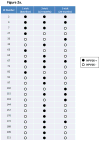Associations between oral HPV16 infection and cytopathology: evaluation of an oropharyngeal "pap-test equivalent" in high-risk populations
- PMID: 21836021
- PMCID: PMC3380432
- DOI: 10.1158/1940-6207.CAPR-11-0284
Associations between oral HPV16 infection and cytopathology: evaluation of an oropharyngeal "pap-test equivalent" in high-risk populations
Abstract
Human papillomavirus (HPV) is responsible for the rising incidence of oropharyngeal squamous cell cancers (OSCC) in the United States, and yet, no screening strategies have been evaluated. Secondary prevention by means of HPV detection and cervical cytology has led to a decline in cervical cancer incidence in the United States. Here, we explored an analogous strategy by evaluating associations between HPV16 infection, cytopathology, and histopathology in two populations at elevated risk for OSCCs. In the first, a cross-sectional study population (PAP1), cytology specimens were collected by means of brush biopsy from patients presenting with oropharyngeal abnormalities. In the second (PAP2), a nested case-control study, bilateral tonsillar cytology samples were collected at 12-month intervals from HIV-infected individuals. The presence of cytopathologic abnormality in HPV16-positive tonsil brush biopsies (cases) was compared with HPV16-negative samples (controls) matched on age and gender. HPV16 was detected in samples by consensus primer PCR and/or type-specific PCR. Univariate logistic regression was used to evaluate associations. In PAP1, HPV16 alone (OR: 6.1, 95% CI: 1.6-22.7) or in combination with abnormal cytology (OR: 20, 95% CI: 4.2-95.4) was associated with OSCC. In PAP2, 4.7% (72 of 1,524) of tonsillar cytology specimens from HIV-infected individuals without oropharyngeal abnormalities were HPV16 positive. Tonsillar HPV16 infection was not associated with atypical squamous cells of unknown significance (ASCUS), the only cytologic abnormality identified. Therefore, HPV16 was associated with OSCCs among individuals with accessible oropharyngeal lesions but not with cytologic evidence of dysplasia among high-risk individuals without such lesions. An oropharyngeal Pap-test equivalent may not be feasible, likely due to limitations in sampling the relevant tonsillar crypt epithelium.
©2011 AACR.
Figures



Similar articles
-
Brush-based cytology screening in the tonsils and cervix: there is a difference!Cancer Prev Res (Phila). 2011 Sep;4(9):1350-2. doi: 10.1158/1940-6207.CAPR-11-0373. Cancer Prev Res (Phila). 2011. PMID: 21893496
-
Human papillomavirus DNA detection in fine-needle aspirates as indicator of human papillomavirus-positive oropharyngeal squamous cell carcinoma: A prospective study.Head Neck. 2017 Mar;39(3):419-426. doi: 10.1002/hed.24641. Epub 2016 Nov 29. Head Neck. 2017. PMID: 27898186
-
Abnormal cytology in oropharyngeal brushings and in oral rinses is not associated with HPV infection: The OHMAR study.Cancer Cytopathol. 2020 Sep;128(9):648-655. doi: 10.1002/cncy.22295. Epub 2020 Jun 2. Cancer Cytopathol. 2020. PMID: 32485093
-
The effectiveness of HPV16 and HPV18 genotyping and cytology with different thresholds for the triage of human papillomavirus-based screening on self-collected samples.PLoS One. 2020 Jun 11;15(6):e0234518. doi: 10.1371/journal.pone.0234518. eCollection 2020. PLoS One. 2020. PMID: 32525936 Free PMC article.
-
Human Papilloma Virus-16 associated primary adenocarcinoma of the tonsil: Report of two cases and literature review.Oral Oncol. 2024 Apr;151:106766. doi: 10.1016/j.oraloncology.2024.106766. Epub 2024 Mar 18. Oral Oncol. 2024. PMID: 38503258 Review. No abstract available.
Cited by
-
Case of an Incidentally Found Squamous Cell Carcinoma of the Tonsil: Are We Underestimating Its Incidence?Cureus. 2019 Dec 14;11(12):e6383. doi: 10.7759/cureus.6383. Cureus. 2019. PMID: 31938661 Free PMC article.
-
Methylation of HPV 16 and EPB41L3 in oral gargles: Associations with oropharyngeal cancer detection and tumor characteristics.Int J Cancer. 2020 Feb 15;146(4):1018-1030. doi: 10.1002/ijc.32570. Epub 2019 Jul 26. Int J Cancer. 2020. PMID: 31304592 Free PMC article.
-
The Impact of Tonsillectomy upon the Risk of Oropharyngeal Carcinoma Diagnosis and Prognosis in the Danish Cancer Registry.Cancer Prev Res (Phila). 2015 Jul;8(7):583-9. doi: 10.1158/1940-6207.CAPR-15-0101. Epub 2015 Apr 20. Cancer Prev Res (Phila). 2015. PMID: 25896236 Free PMC article.
-
cfDNA detection for HPV+ squamous cell carcinomas.Oral Oncol. 2021 Apr;115:104958. doi: 10.1016/j.oraloncology.2020.104958. Epub 2021 Feb 11. Oral Oncol. 2021. PMID: 33582486 Free PMC article. Review.
-
HPV detection methods in head and neck cancer.Head Neck Pathol. 2012 Jul;6 Suppl 1(Suppl 1):S63-74. doi: 10.1007/s12105-012-0372-5. Epub 2012 Jul 3. Head Neck Pathol. 2012. PMID: 22782225 Free PMC article. Review.
References
-
- D’Souza G, Kreimer AR, Viscidi R, Pawlita M, Fakhry C, Koch WM, Westra WH, Gillison ML. Case-control study of human papillomavirus and oropharyngeal cancer. N Engl J Med. 2007;356:1944–1956. - PubMed
-
- Gillison ML, Koch WM, Capone RB, Spafford M, Westra WH, Wu L, Zahurak ML, Daniel RW, Viglione M, Symer DE, Shah KV, Sidransky D. Evidence for a causal association between human papillomavirus and a subset of head and neck cancers. J Natl Cancer Inst. 2000;92:709–720. - PubMed
-
- Saslow D, Runowicz CD, Solomon D, Moscicki AB, Smith RA, Eyre HJ, Cohen C. American Cancer Society Guideline for the Early Detection of Cervical Neoplasia and Cancer. J Low Genit Tract Dis. 2003;7:67–86. - PubMed
-
- Gustafsson L, Ponten J, Bergstrom R, Adami HO. International incidence rates of invasive cervical cancer before cytological screening. Int J Cancer. 1997;71:159–165. - PubMed
-
- Gustafsson L, Ponten J, Zack M, Adami HO. International incidence rates of invasive cervical cancer after introduction of cytological screening. Cancer Causes Control. 1997;8:755–763. - PubMed
Publication types
MeSH terms
Grants and funding
LinkOut - more resources
Full Text Sources
Research Materials

